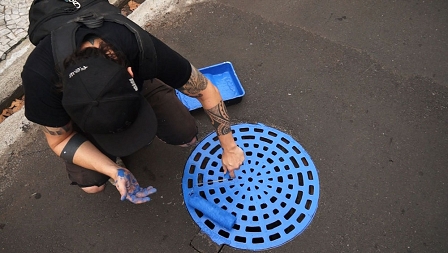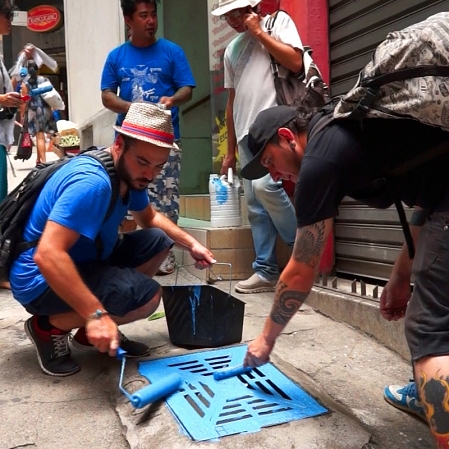Erstellt am: 16. 4. 2016 - 06:03 Uhr
The Blue City of Brazil
It is easy but dangerous to lose touch with nature in the city. And that is why a group of artists have been dousing the streets of Brazil’s most populous city in blue paint.

Thiago Lucena
São Paulo, which has recently been suffering from drastic water shortages, is actually built on 300 waterways; but you’d have to forgive the visitor for not noticing. Polluted over generations by the filth and poison of the fast developing city, they have been mostly hidden, covered in concrete. Out of sight, out of mind, you might say.
Dieses Element ist nicht mehr verfügbar
"For centuries cities have treated their rivers as sewage channels and buried them," says the artists’ collective called Cidade Azul, or Blue City, which aims, eventually, to reintegrate the living waterways into the city
The Sounds Of Water
"We’d like them back. And that means we will have to work out how to clean them. And we have to do that as a community," Carolina Ferres of Cidade Azul, told me at a recent session of the Salzburg Global Seminar.
Bringing the rivers back to the surface would be a big project and a long process, of course. So for now Cidade Azul are merely painting the streets blue along the path of the subterranean waterways and placing speakers near the buried water courses that play the sounds of running water.

Ana Cenamo
"For now we are simply raising awareness about the existence of these rivers," says Ferres. "By painting the streets blue we are making the connection between people and the rivers. Most people don’t even know the rivers are there."
Reminding people of the presence of these rivers, is a way of reconnecting them with nature. "People in cities always seem to think that the environment is elsewhere. But of course it is in the cities too. You just have to look for it. And rivers are pathways."

Thiago Lucena
The water crisis in São Paulo has led many to remember the importance of water and the importance of managing it. "The water shortage in São Paulo is a political crisis," says Ferres. "It’s the way we design our water supply." She says that statistics show it has rained more and more every year in recent time in the city and yet the taps run dry. "Sometimes it is raining outside but you don’t have any running water in your home."
This Saturday’s Reality Check special, at 12 noon on the 16th April, examines the role artists and the creative community can play in fighting for a cleaner and healthy environment for the future
The team of Cidade Azul dream of the return of the waterways "free and clean, integrated and transformed to fit the urban landscape", with perhaps, "gardens along the water’s edge."
It seems like a distant dream, but the future has always belonged to dreamers.
Also starring in today’s show: the Brazilian street artist Mundano who says he is trying to use humour to push for political change. “I want to use fun to facilitate talk about serious issues,” he told me. His way of dealing with the drought in his home city of São Paulo has been to place plastic cacti – which he describes as symbols of the desert – into the empty reservoirs and put taps on them. “We are saying that our last option is to take water out of the cactus. It’s a powerful image. There’s humour but there is also drama.”
Provoking a Debate
For example he and his team painted "carroças," the wooden and metal carts used by the trash collectors – in bright vibrant colours – drawing attention to the valuable environmental and social importance role they play in the fight for a better environment. In São Paulo, for example, 17,000 tons of garbage are generated every day, and only 1% is recycled. By drawing attention to the work of the recyclers, Mundano hopes to improve that figure.
“I’m trying to create a fun and new way to address these issues, so that people will take photos and share them on social media. The maybe mass media will take up the story and people will realize that this is an issue that we have to talk about.”
He says that art can be a powerful weapon because ordinary citizens are often bored by the facts and figures that are thrown about in the (vital) scientific debate. If the fight against environmental degradation and climate change is to by successful it has to find a way into people's hearts. “We need to be popular,” says Mundano, “People need easy things that they can share, that they can agree on and from there we can move forward.”
His weapon is humour but his battle is deadly serious: “We live on a shared planet with no boundaries and we are destroying it every day. We need to work together.”


